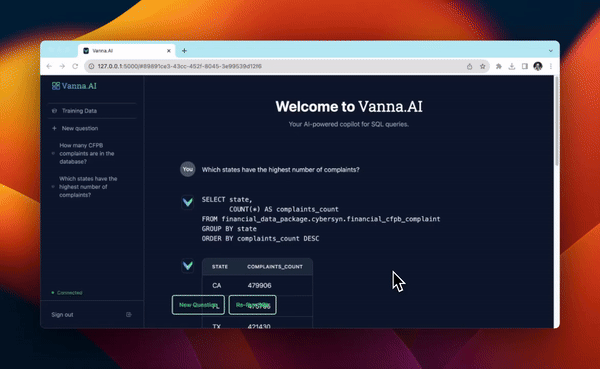使用 Mistral 经由 Mistral API、Qdrant 为 Snowflake 生成 SQL
您想使用哪个 LLM?
使用您自己的 API 密钥使用 OpenAI
-
Azure OpenAI如果您在 Azure 上部署了 OpenAI 模型
-
通过 La plateforme 使用 MistralAnthropic
-
使用您的 Anthropic API 密钥使用 Anthropics Claude在本地免费使用 Ollama。需要额外设置。
-
GeminiGoogle Gemini
-
使用您的 Gemini 或 Vertex API 密钥使用 Google Gemini[已选择] 通过 Mistral API 使用 Mistral
-
如果您有 Mistral API 密钥其他 LLM
-
如果您有不同的 LLM 模型您想将“训练”数据存储在哪里?
ChromaDB
-
在本地免费使用 ChromaDB 的开源向量数据库。无需额外设置 -- 所有数据库文件将在本地创建和存储。[已选择] Qdrant
-
使用 Qdrant 的开源向量数据库在本地免费使用 Marqo。需要额外设置。或者使用他们的托管选项。
-
其他向量数据库其他向量数据库
-
使用任何其他向量数据库。需要额外设置。您想查询哪个数据库?
训练
%pip install 'vanna[qdrant,mistralai,snowflake]'
from vanna.qdrant import Qdrant_VectorStore
from qdrant_client import QdrantClient
from vanna.mistral import Mistral
class MyVanna(Qdrant_VectorStore, Mistral):
def __init__(self, config=None):
Qdrant_VectorStore.__init__(self, config=config)
Mistral.__init__(self, config={'api_key': MISTRAL_API_KEY, 'model': 'mistral-tiny'})
vn = MyVanna(config={'client': 'QdrantClient(...)'})
Postgres
-
Microsoft SQL Server
-
[已选择] Snowflake
-
Oracle
-
Microsoft SQL
-
使用 Vanna 为任何 SQL 数据库生成查询
-
SQLite
-
其他数据库
-
Snowflake
-
LLM您只需训练一次。除非您想添加更多训练数据,否则无需再次训练。
vn.connect_to_snowflake(
account="myaccount",
username="myusername",
password="mypassword",
database="mydatabase",
role="myrole",
)
启动用户界面

# The information schema query may need some tweaking depending on your database. This is a good starting point.
df_information_schema = vn.run_sql("SELECT * FROM INFORMATION_SCHEMA.COLUMNS")
# This will break up the information schema into bite-sized chunks that can be referenced by the LLM
plan = vn.get_training_plan_generic(df_information_schema)
plan
# If you like the plan, then uncomment this and run it to train
# vn.train(plan=plan)
# The following are methods for adding training data. Make sure you modify the examples to match your database.
# DDL statements are powerful because they specify table names, colume names, types, and potentially relationships
vn.train(ddl="""
CREATE TABLE IF NOT EXISTS my-table (
id INT PRIMARY KEY,
name VARCHAR(100),
age INT
)
""")
# Sometimes you may want to add documentation about your business terminology or definitions.
vn.train(documentation="Our business defines OTIF score as the percentage of orders that are delivered on time and in full")
# You can also add SQL queries to your training data. This is useful if you have some queries already laying around. You can just copy and paste those from your editor to begin generating new SQL.
vn.train(sql="SELECT * FROM my-table WHERE name = 'John Doe'")
# At any time you can inspect what training data the package is able to reference
training_data = vn.get_training_data()
training_data
# You can remove training data if there's obsolete/incorrect information.
vn.remove_training_data(id='1-ddl')
```## Asking the AI
Whenever you ask a new question, it will find the 10 most relevant pieces of training data and use it as part of the LLM prompt to generate the SQL.
```python
vn.ask(question=...)
本笔记详细介绍了如何使用 vanna Python 包通过 AI (RAG + LLM) 生成 SQL,包括连接数据库和训练。如果您还没准备好在自己的数据库上进行训练,您仍然可以使用示例 SQLite 数据库进行尝试。

from vanna.flask import VannaFlaskApp
app = VannaFlaskApp(vn)
app.run()